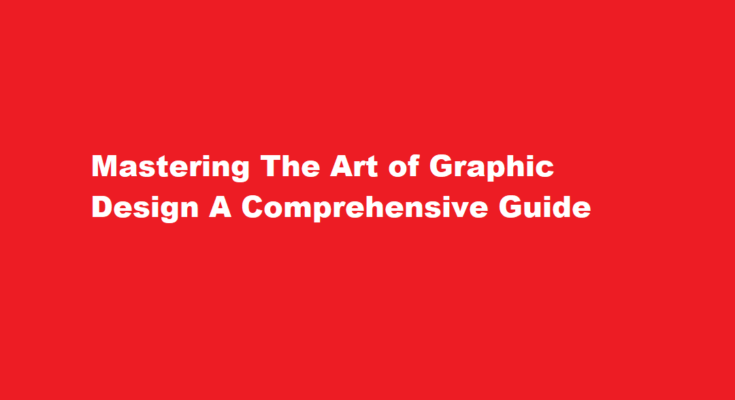Introduction
Graphic design is a dynamic and ever-evolving field that combines creativity, technology, and communication to convey messages visually. Whether you’re a budding artist or someone looking to transition into the world of design, understanding how to be a graphic designer is crucial. This comprehensive guide will walk you through the essential steps and skills needed to embark on a successful graphic design journey.
Develop a Strong Foundation
The first step in becoming a graphic designer is to build a solid foundation in design principles. This includes understanding elements like color theory, typography, layout, and composition. Start by studying these fundamental concepts through books, online courses, or formal education.
Acquire the Necessary Tools
Graphic design relies heavily on digital tools and software. Invest in a high-quality computer or laptop, a graphics tablet, and industry-standard software like Adobe Creative Suite (Photoshop, Illustrator, InDesign) or other alternatives such as CorelDRAW or GIMP.
Master Graphic Design Software
Familiarize yourself with your chosen software. Learn the ins and outs of each program, from basic operations to advanced techniques. Many online tutorials and courses can help you become proficient in these essential tools.
Develop Your Artistic Skills
Graphic designers need a keen eye for aesthetics. Practice drawing, sketching, and painting to improve your artistic abilities. This will help you create original designs and add a personal touch to your work.
Understand Your Audience
Effective graphic design is about communicating a message to a specific audience. Before starting any project, research and understand your target audience’s preferences, needs, and demographics. Tailoring your designs to their tastes will make your work more impactful.
Create a Strong Portfolio
A portfolio is your visual resume, showcasing your skills and creativity to potential clients or employers. Compile a diverse range of your best work, including personal projects, freelance assignments, or internships. A strong portfolio can open doors to job opportunities and freelance work.
Stay Current with Design Trends
Graphic design is a constantly evolving field. Stay up-to-date with current design trends by following industry blogs, attending design conferences, and joining design communities online. Being aware of trends will help you produce relevant and appealing work.
Develop Strong Communication Skills
Graphic designers need to collaborate with clients, art directors, and other team members. Effective communication is key to understanding project requirements, receiving feedback, and conveying your design choices. Improve your written and verbal communication skills to excel in this aspect of the profession.
Experiment and Innovate
Don’t be afraid to push the boundaries of design. Experiment with different styles, techniques, and mediums to discover your unique artistic voice. Innovation and creativity are highly valued in the graphic design industry.
Build a Professional Network
Networking is crucial in any industry. Attend industry events, join online forums, and connect with other designers and professionals. Building a strong network can lead to valuable mentorships, collaborations, and job opportunities.
Time Management and Organization
Graphic design often involves multiple projects with varying deadlines. Effective time management and organization skills are essential to meet client expectations and deliver high-quality work consistently.
Understand the Business Side
Graphic designers often work as freelancers or run their own design studios. Understanding the business side of design is essential. Learn about contracts, pricing, invoicing, and marketing to ensure a successful career.
Seek Feedback and Continuous Improvement
Don’t shy away from constructive criticism. Seek feedback from peers, mentors, or clients to improve your skills. Continuous learning and self-improvement are key to staying competitive in the field.
Stay Inspired
Inspiration can come from various sources, including art, nature, and everyday life. Keep a sketchbook or digital journal to jot down ideas and sketches. Surround yourself with sources of inspiration to keep your creative juices flowing.
Be Adaptable
The design industry is subject to change due to technological advancements and shifts in design trends. Be adaptable and open to learning new tools and techniques to remain relevant in the field.
Frequently Asked Questions
What are the 7 rules of graphic design?
The fundamental principles of design are Emphasis, Balance and Alignment, Contrast, Repetition, Proportion, Movement and White Space. Design differs from art in that it has to have a purpose. Visually, this functionality is interpreted by making sure an image has a center of attention, a point of focus.
What are the 12 principles of graphics?
There are twelve basic principles of design: contrast, balance, emphasis, proportion, hierarchy, repetition, rhythm, pattern, white space, movement, variety, and unity.
Conclusion
Becoming a graphic designer is an exciting and fulfilling journey that requires dedication, creativity, and continuous learning. By developing a strong foundation in design principles, mastering the necessary tools, and staying updated with industry trends, you can embark on a successful career in graphic design. Remember to build a strong portfolio, network with fellow professionals, and always strive for improvement. With determination and passion, you can turn your artistic talents into a thriving profession in the world of graphic design.
Read Also : How to Be a Part of Parliament A Path to Public Service



